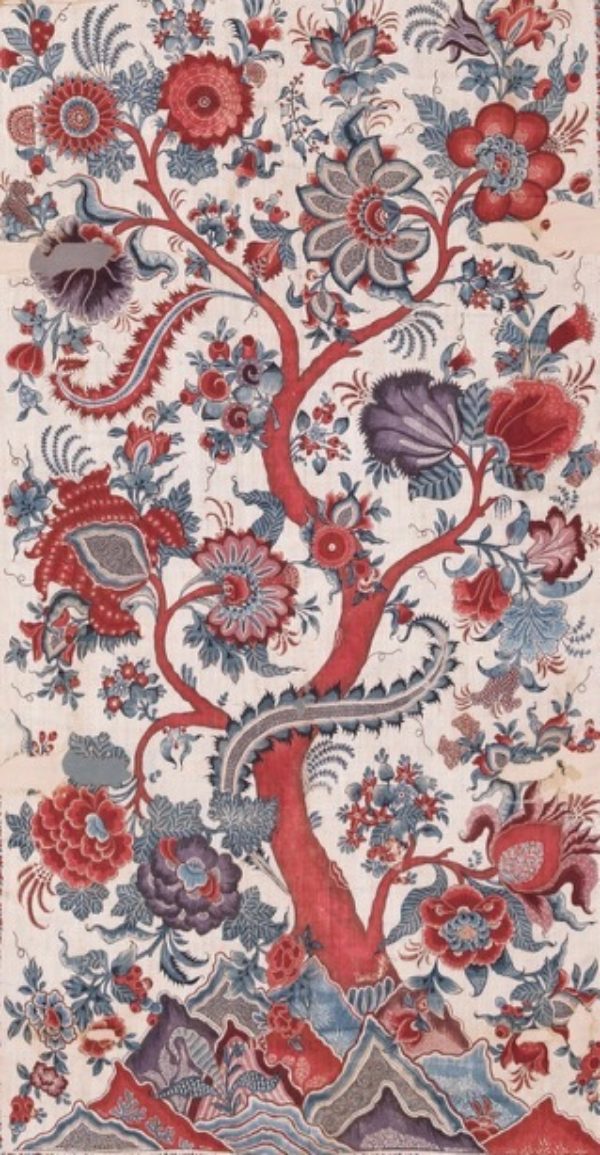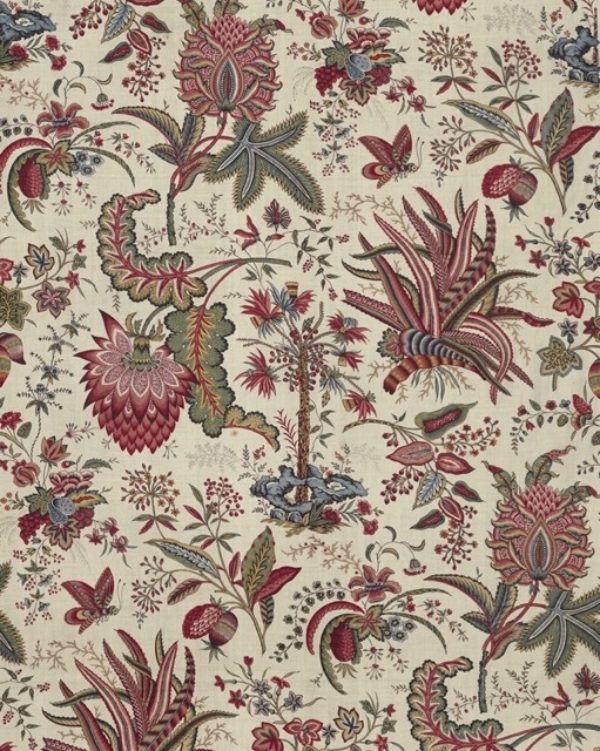Before Drug Prohibition, There Was the War on Calico
Reason , July 2018
On a shopping trip to the butcher's, young Miss la Genne wore her new, form-fitting jacket, a stylish cotton print with large brown flowers and red stripes on a white background. It got her arrested.
Another young woman stood in the door of her boss' wine shop sporting a similar jacket with red flowers. She too was arrested. So were Madame de Ville, the lady Coulange, and Madame Boite. Through the windows of their homes, law enforcement authorities spotted these unlucky women in clothing with red flowers printed on white. They were busted for possession.
It was Paris in 1730, and the printed cotton fabrics known as toiles peintes or indiennes—in English, calicoes, chintzes, or muslins—had been illegal since 1686. It was an extreme version of trade protectionism, designed to shelter French textile producers from Indian cottons. Every few years the authorities would tweak the law, but the fashion refused to die.
Frustrated by rampant smuggling and ubiquitous scofflaws, in 1726 the government increased penalties for traffickers and anyone helping them. Offenders could be sentenced to years in galleys, with violent smugglers put to death. Local authorities were given the power to detain without trial anyone who merely wore the forbidden fabrics or upholstered furniture with them.
"The exasperation of the lawmakers, after forty years of successive edicts and ordinances which had been largely ignored, flouted or circumvented on a wholesale basis, can be sensed in this law," writes the fashion historian Gillian Crosby in a 2015 dissertation on the ban. Her archival research shows a spike in arrests for simple possession. "Impotent at stopping the cross-border trade, printing or the peddling of goods," she writes, "government officials concentrated on making an example of individual wearers, in an attempt to halt the fashion."
They failed.
In the annals of prohibition, the French war on printed fabrics is one of the strangest, most futile, and most extreme chapters. It's also one of the most intellectually consequential, producing many of the earliest arguments for economic liberalism. "Long before the more famous debates about the liberalisation of the grain trade, about taxation, or even about the monopoly of the French Indies Company, philosophes and Enlightenment political economists saw the calico debate as their first important battleground," writes the historian Felicia Gottmann in Global Trade, Smuggling, and the Making of Economic Liberalism (Palgrave Macmillan).
Other European countries, including England, prohibited calico imports during the same period, but France went the furthest. It blocked not only imported prints but plain-fabric imports and forbade domestic printing, even on French-made cloth. The French prohibition also lasted the longest, stretching for 73 years. It never worked.
Calicoes were popular for good reason. Introduced by Portuguese traders in the 16th century, the Indian fabrics were unlike anything Europeans had ever seen. The blues and reds were spectacular and, thanks to dyeing skills honed over centuries, the colors survived laundering.
Printed fabric for clothing was itself new to Europe, providing an irresistible cornucopia of pictorial designs. Savvy Indian producers adapted their patterns to local tastes and offered new styles as fashions shifted.
Even without decoration, the finely spun cotton cloth made for more comfortable undergarments than the linen previously in use—and at a lower price. Inexpensive, easily washable muslin allowed poorer people to more frequently change the shifts they wore next to their skin.
And indiennes offered something for every income. An aristocratic lady might wear a finely painted skirt to court while, for less than a day's wages, a servant girl could spruce up her drab ensemble with a floral kerchief. "The trick to their success," writes Gottmann, "was that they came in a vast range of qualities, from the finest hand-painted chintzes to the cheapest block-printed or dyed calicoes."

By the mid-17th century, indiennes were everywhere, on everyone. French silk, linen, and wool manufacturers were not pleased. As the country's largest export industry, textiles provided an influx of currency, which economic doctrine at the time held essential to national wealth. In October 1686, the royal council banned the popular prints to protect local producers.
Even the supposedly absolutist rule of Louis XIV, however, faced conflicting demands. Notably, the French East India Company, owned by the king and his courtiers, wanted to sell calico. To preserve its lucrative trade, the council let it auction fabric to be sent abroad. Smugglers took advantage.
Forbidden fabrics came across the border from Holland, Switzerland, and Savoy. They crept in through Avignon, which was then under papal control, and out of ships and warehouses in Marseille, where they were supposedly destined for re-export. State-sanctioned auctions attracted bidders stocking up on calico to trade for slaves in West Africa, which was legal, and those planning to sell it in the French West Indies, which was not. "Switzerland and the Channel Islands, who top the list of foreign buyers, were the two main entrepôts for smuggling textiles into France," Gottmann observes.
Anyone in France who wanted calico—and most everyone did—could get it. Worn by the country's most fashionable women within sight of its most powerful men, the prestige of indiennes never dimmed. And so instead of building the kingdom's wealth, the ban turned countless citizens into outlaws.
It also stifled the development of a French fabric-printing industry even as startups in England, Holland, and Switzerland were devising their own successful techniques. Their prints weren't as fine as Indian textiles, but they were good enough for many customers, including in France.

Finally in the 1740s, the regime granted a few entrepreneurs the right to print on domestic fabrics, including cotton from French colonies. Once these enterprises were producing acceptable prints, the clamor for legalizing Indian imports increased. After all, even Jean-Baptiste Colbert, the father of French dirigisme, had argued only for protecting new industries.
To the mercantilist argument that permitting domestic calico production would be good for French industry, economic liberals added a novel point. The law was unjust, penalizing the many for the benefit of the few. "Is it not strange," wrote the Abbé André Morellet in a 1758 tract against the ban, "that an otherwise respectable order of citizens solicits terrible punishments such as death and the galleys against Frenchmen, & does so for reasons of commercial interest? Will our descendants be able to believe that our nation was truly as enlightened and civilized as we now like to say when they read that in the middle of the eighteenth century a man in France was hanged for buying in Geneva at 22 sous what he was able to sell in Grenoble for 58?"
The textile business, Morellet reminded readers, was not the French nation but only a tiny fraction of it. "It was the cruelty of the system of repression, not any single instance of it, that the author wished to emphasize," writes historian Michael Kwass in Contraband (Harvard University Press).
The ban was lifted in 1759, giving anti-prohibitionists a partial victory. The regime opted for a 25 percent tariff, enough to keep smuggling profitable. Once in the country, the duty-skirting fabrics could now pass as legitimate.
Nonetheless, and despite their late start, French entrepreneurs were able to develop a successful calico industry, eventually perfecting the new technology of copper-plate printing. Domestic cottons such as toile de jouy became as fashionable as exotic indiennes. And French citizens were no longer imprisoned for donning flowery aprons, sitting on chintz upholstery, or bedecking their beds with toiles peintes.
Photos courtesy of the Metropolitan Museum of Art.